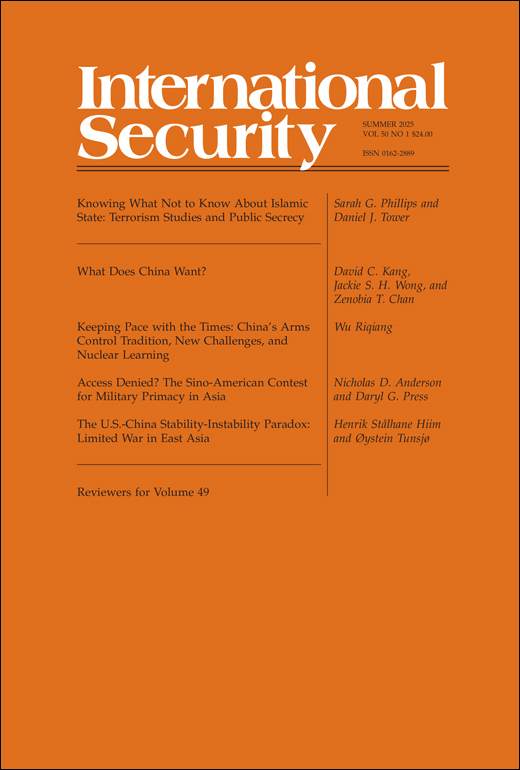
作者/Author(s): Henrik Stalhane Hiim and Oystein Tunsjo
網站來源/Source: International Security, Vol. 50, No. 1
日期/Date: 夏季/2025
關鍵字/Keywords: 戰爭、地理、科技、美中
摘要:
美中現今正處於類似美蘇冷戰的戰略競爭中。有一派國關學者假設,兩個擁核大國形成的「兩極秩序」,有助於提升穩定性。然而,其中存在「穩定—不穩定悖論」(stability-instability paradox):由核武與相互保證毀滅支撐的戰略層面穩定,反而可能增加低層級衝突發生的機率。換言之,大規模戰爭不太可能爆發,但有限戰爭卻有可能發生。影響有限戰爭爆發機率的兩大條件,是主要衝突戰區的地理特徵與軍事技術。作者根據此理論指出,相較於美蘇冷戰時期,當今中美爆發有限戰爭的可能性更高,對台灣而言是極為嚴峻的警訊。
「穩定—不穩定悖論」與有限戰爭
「穩定—不穩定悖論」與有限戰爭
- 在兩極體系下,核嚇阻大幅降低了大規模戰爭的可能性,因為各方都害怕相互保證毀滅的後果。然而,大國只要控制投入的軍事資源,並避免採到升級衝突的紅線,便可以參加有限戰爭。
- 手段、地理範圍與目標皆可能限制戰爭規模。大國可能會約束自我,只參與區域戰爭,將衝突限於特定區域,同時避免採到核紅線。
- 「穩定—不穩定悖論」便因運而生:大國害怕核升級所以不會爆發全面戰爭,但為了競爭,仍可能展開低層級、有限規模的戰爭,美蘇冷戰中的代理人戰爭便是典型例證。
- 自中國擴充並推動核武庫現代化後,各界擔憂美中兩國是否會爆發大規模戰爭,抑或是維持類似冷戰的格局。地理環境與軍事技術儼然成為決定戰爭爆發可能性的關鍵因素。
- 地理因素可能限制戰爭規模。水域或其他地理障礙是最天然的屏障,能阻擋入侵或將戰爭限於特定區域;相對地,缺乏地理屏障的陸戰更難防禦,風險也更高。然而,「穩定—不穩定悖論」指出,正是因為地理因素能將戰爭限制在特定區域,反而增加了有限戰爭爆發的可能性。
- 軍事技術可透過精準導引武器打擊目標、減少傷亡、執行情報、監視、目標獲取與偵察任務(ISTAR),或先削弱敵人後再發動攻擊。這些能力讓大國得以精確打擊、防止衝突升高,達到限制戰爭規模的目的。然而,低當量核武器與臨時目標定位系統等新科技,可能讓原子武器變得常態化。
Summary:
The US and China are in a strategic rivalry akin to the US-Soviet Cold War. International scholars hypothesized that a bipolar order with nuclear-armed great powers improves stability. Nevertheless, a "stability-instability paradox" exists, where stability at the strategic level, backed by nuclear arms and mutually assured destruction, may increase the odds of lower-level conflict. In other words, major wars are unlikely, but limited wars are possible. Two conditions —the geography of the main conflict theater and military technology — influence the chances of limited war. Under these factors, the authors argued that a limited war between the US and China is more possible than during the US-Soviet Cold War, with glaring warnings to Taiwan.
The Stability-Instability Paradox and Limited War
The Stability-Instability Paradox and Limited War
- Under bipolarity, nuclear deterrence significantly reduces the possibility of major wars due to the fear of mutually assured destruction. However, great powers may engage in a limited war by constraining their combat resources and avoiding crossing the escalation red line.
- Means, geographical scope, and objectives could limit wars. Great powers may limit their involvement in regional wars and contain conflicts within specific areas, while avoiding the crossing of the nuclear threshold.
- Consequently, it created the "stability-instability paradox," where great powers do not engage in major war due to fear of nuclear escalation. However, since the great powers aim to outcompete one another, they may engage in lower-level, limited wars, exemplified by the US-Soviet proxy wars.
- Since China expanded and modernized its nuclear inventories, there are concerns about whether the US and China will engage in a major war or whether it will be similar to the Cold War. Yet, geography and military technology will determine the likelihood of war breaking out.
- Geography could limit war. Water or other geographical obstacles are natural barricades to prevent invasions or localize wars. In contrast, the lack of barriers on land makes it more difficult to defend; therefore, land conflicts are high-stakes. However, the stability-instability paradox suggests that since geography could contain war within a specific area, it makes limited war more likely.
- Military technology could limit war by striking targets using precision-guided munitions, reducing casualties, conducting ISTAR operations, or weakening adversaries before an attack, thereby attacking precise targets while preventing a conflict from escalating. Yet, innovations, especially the creation of low-yield nuclear weapons and improvised targeting systems, could normalize the use of atomic weapons.
